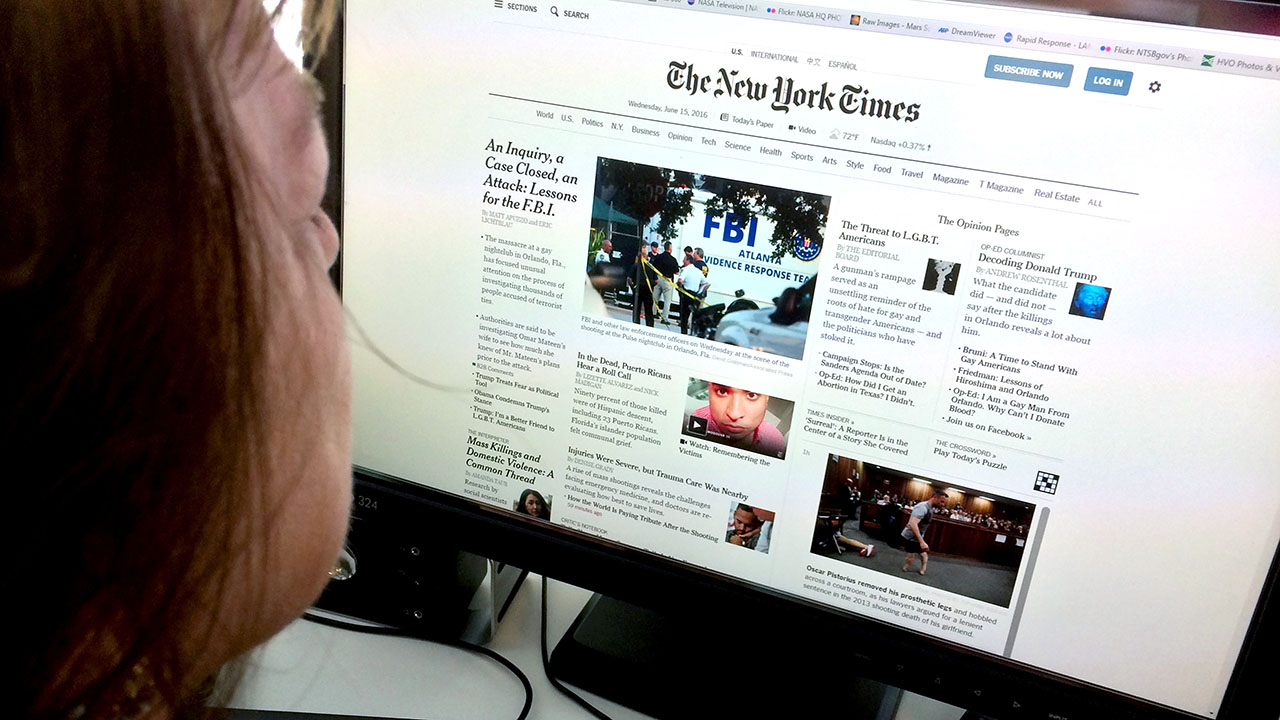The Impact of Social Media Site heading We Eat News Online
Social media has actually fundamentally changed news intake. It provides immediate accessibility to details, typically overshadowing typical media electrical outlets. This fast circulation comes with obstacles. Users face the threat of experiencing misinformation and ending up being caught in resemble chambers. The formulas driving customized web content can cover diverse perspectives. As these dynamics advance, understanding their effects comes to be vital for informed engagement in public discussion. What techniques might aid navigate this facility landscape?
The Development of News Intake in the Digital Age
As innovation progressed, the way individuals consumed news changed substantially in the digital age (stnews.live). Standard papers and transmitted media started to decrease as the net emerged as a primary resource of details. On-line systems offered instant access to newspaper article, video clips, and podcasts, permitting customers to remain educated any time. The ease of mobile tools better accelerated this shift, making it possible for users to obtain updates on the go
Additionally, the surge of news aggregators and web sites assisted in the consumption of varied viewpoints, equipping customers to tailor their news consumption based on individual passions. This evolution also triggered news companies to adapt their strategies, focusing on digital web content and appealing visitors via multimedia styles. Consequently, the typical barriers of time and area in news delivery decreased, leading to an extra instant and customized news experience for audiences worldwide.
The Role of Social Network Platforms in News Distribution
Social media systems have transformed news distribution by providing immediate accessibility to information. Their algorithm-driven content curation frequently focuses on engagement over precision, bring about considerable integrity challenges (stnews.live). As customers navigate this landscape, the implications for news usage and public discourse become significantly complex
Instant News Accessibility
Traditional news outlets have actually long been the main source of details, the rise of social media platforms has actually substantially transformed exactly how news is accessed and taken in. Instant news accessibility has ended up being a trademark of the digital age, allowing users to obtain updates in actual time. Systems such as Twitter, Facebook, and Instagram enable news to spread swiftly, usually surpassing traditional media in rate and reach. Users can share tales, discuss occasions, and engage with journalists, producing a vibrant communication in between the audience and news material. This immediacy promotes a society of necessity, motivating individuals to seek information rapidly. Subsequently, the expectation for timely news has actually reshaped journalistic practices, engaging wire service to adapt their methods to fulfill the demands of a hectic electronic atmosphere.
Algorithm-Driven Material
While customers actively engage with content on social media sites, the formulas that govern these platforms play a pivotal role in identifying which newspaper article get exposure. These formulas assess individual behavior, preferences, and involvement metrics to curate personalized news feeds. As an outcome, certain stories may be amplified while others continue to be rare, frequently focusing on mind-blowing or trending subjects over substantive reporting. This careful direct exposure shapes customers' perceptions of current events and influences public discourse. Furthermore, the reliance on algorithm-driven content can produce echo chambers, where users are mainly subjected to viewpoints that line up with their very own beliefs. As a result, the dynamics of news distribution on social media systems considerably influence exactly how people eat and translate information in the digital age.

Reputation Challenges
As customers increasingly turn to social networks for news, the reliability of details come across on these systems becomes a pressing issue. The decentralized nature of social media sites enables any individual to publish content, typically blurring the lines between trusted journalism and false information. Algorithms focus on interaction over accuracy, leading to the extensive dissemination of astonishing or misleading stories. This setting positions substantial obstacles for customers attempting to determine reliable resources. Social network systems, while endeavoring to combat misinformation with fact-checking and content small amounts, face objection for incongruities and predispositions in their strategies. Inevitably, the obligation exists with individuals to critically evaluate the news they eat, as the fast spread of info often outpaces confirmation efforts by systems.
The Increase of Resident Journalism and User-Generated Web Content
The surge of citizen journalism has empowered day-to-day people to share news and perspectives, often offering insights that conventional media might ignore. However, this shift also presents considerable challenges, especially the spread of false information that can develop from unverified web content. As user-generated material comes to be a lot more prevalent, the balance in between genuine voices and precision in coverage remains a crucial problem.
Equipping Everyday Voices

Difficulties of Misinformation
While the surge of person journalism has actually opened up avenues for varied voices in find here the media landscape, it has likewise presented significant difficulties associated with misinformation. The convenience of sharing information via social media sites systems permits individuals to distribute news swiftly, yet this fast spread often comes at the price of accuracy. User-generated content frequently lacks the extensive fact-checking and editorial oversight that standard journalism offers. As a result, sensationalized or incorrect stories can gain traction, misinforming target markets and forming public understanding (stnews.live). Moreover, the blending of viewpoint and truth within social networks makes complex the distinction in between reputable details and misinformation. Because of this, customers need to browse a progressively complex media environment, needing essential assuming skills to discern reliable news sources among the sound

Misinformation and Its Effects for Public Discussion
As social networks platforms significantly dominate the landscape of details circulation, the spreading of misinformation positions significant obstacles for public discussion. Misinformation, commonly designed to misguide or prompt psychological actions, can distort perceptions of fact and weaken rely on reputable resources. This sensation leads to polarized perspectives, as individuals are attracted in the direction of resemble chambers that reinforce their ideas, better entrenching departments within society.
The effects for public discourse are profound. When citizens depend on incorrect info, meaningful discussion diminishes, and the democratic procedure experiences. Furthermore, misinformation can incite concern and confusion, affecting public health and wellness, safety and security, and political stability. Therefore, promoting media proficiency ends up being vital, encouraging people to critically evaluate info and recognize reality from fiction. Dealing with the obstacles posed by misinformation is critical for maintaining the honesty of public discussion and guaranteeing a well-informed people efficient in participating in useful discussions.
The Impact of Algorithms on News Exposure
Provided the main role of formulas in identifying material presence, their impact on news intake is profound. These algorithms, utilized by social networks systems, prioritize particular sorts of material based upon customer involvement and choices. Therefore, newspaper article that align with popular fads or audience interests are most likely to be displayed plainly, while less marvelous stories might be ignored. This produces an atmosphere where individuals are revealed primarily to details that enhances their perspectives, possibly causing echo chambers.
The constant development of algorithms suggests that news companies have to adapt their approaches to align more info here with these transforming criteria, often focusing on clickbait or psychologically billed headings. The stability of news reporting can be jeopardized, as essential stories might not obtain the presence they are entitled to. The mathematical shaping of news visibility consequently plays an important duty in influencing public perception and understanding of current events.
The Change Towards Visual Narration in News Media
Progressively, news media is embracing visual narration as an effective device to involve audiences. This strategy leverages photos, video clips, infographics, and interactive aspects to share details more successfully than conventional text-based styles. As interest covers reduce, visuals provide a quick, impactful way to connect complicated stories and get hold of customers' interest.
Systems like Instagram and TikTok have further increased this pattern, engaging news companies to adapt their content strategies to fit these visually-driven settings. By incorporating engaging visuals, news outlets can improve psychological connections and foster greater understanding of topical problems.
Aesthetic storytelling enables for even more varied narratives, showcasing several perspectives through vibrant discussions. As audiences significantly consume news through smart phones, the shift toward visuals not just provides to user preferences but also aids to break down obstacles to details access. Inevitably, this development mirrors a broader transformation in how news is produced and consumed in the digital age.
Future Patterns: Browsing the Altering Landscape of News Usage
While the electronic landscape remains to evolve, news consumption is positioned for significant transformation driven by emerging technologies and changing target market behaviors. As synthetic intelligence and artificial intelligence development, customized news feeds will certainly become much more widespread, allowing individuals to receive content tailored to their rate of interests. This customization might result in greater interaction but likewise raise concerns concerning echo chambers and misinformation.
In addition, the rise of voice-activated tools and clever speakers will affect just how news is provided, moving the focus from visual to acoustic formats. This pattern might urge wire service to adopt even more concise and engaging audio web content.

Often Asked Questions
Exactly How Do Social Media Interactions Affect News Reliability?
Social media site interactions can substantially influence understandings of news reliability. Interaction metrics, such as sort and shares, frequently form target market count on, with prominent articles gaining perceived authenticity, regardless of the accuracy or dependability of the info presented.
What Function Do Influencers Play in Shaping News Narratives?
Influencers greatly form news stories by leveraging their systems to enhance certain tales, frequently customizing web content to their target market. This can result in biased perspectives, impacting public understanding and prioritizing sensationalism over valid coverage.
Exactly How Can Users Identify Reliable News Resources on Social Network?
Customers can determine dependable news resources on social media by examining the resource's credibility, verifying truths via multiple outlets, evaluating the professionalism and reliability of the content, and recognizing potential predispositions in reporting to guarantee precise info.
What Influence Does Social Media Site Have on Standard Journalism Jobs?
Social media site significantly affects traditional journalism tasks by changing revenue designs, lowering need for print media, and cultivating competitors from citizen journalists. Consequently, many professionals deal with task instability and have to adjust to rapidly changing media landscapes.
How Do Different Demographics Consume News on Social Media?
Various demographics display different preferences for news consumption on social media. Younger target markets favor systems like TikTok and Instagram for quick updates, while older people have a tendency to like Facebook and Twitter for extra extensive conversations and short articles.